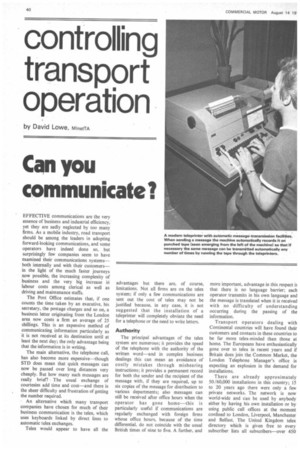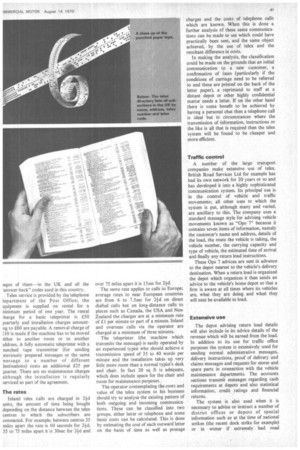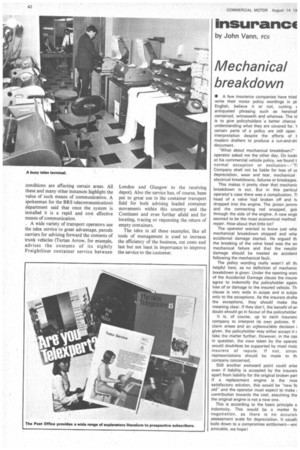controlling transport operation
Page 42

Page 43

Page 44

If you've noticed an error in this article please click here to report it so we can fix it.
by David Lowe, minstTA
Can you communicate?
EFFECTIVE communications are the very essence of business and industrial efficiency, yet they are sadly neglected by too many firms. As a mobile industry, road transport should be among the leaders in adopting forward-looking communications, and some operators have indeed done so, but surprisingly few companies seem to have examined their communications systems— both internally and with their customers— in the light of the much faster journeys now possible, the increasing complexity of business and the very big increase in labour costs among clerical as well as driving and maintenance staffs.
The Post Office estimates that, if one counts the time taken by an executive, his secretary, the postage charges and so on, a business letter originating from the London area now costs a firm an average of 25 shillings. This is an expensive method of communicating information particularly as it is not received at its destination until at least the next day; the only advantage being that the information is in writing.
The main alternative, the telephone call, has also become more expensive—though STD does mean that quick messages can now be passed over long distances very cheaply. But how many such messages are really brief? The usual exchange of courtesies add time and cost—and there is the sheer difficulty and frustration of getting the number required.
An alternative which many transport companies have chosen for much of their business communication is the telex, which uses keyboards linked by direct lines to automatic telex exchanges.
Telex would appear to have all the advantages but there are, of course, limitations. Not all firms are on the telex system; if only a few communications are sent out the cost of telex may not be justified because, in any case, it is not suggested that the installation of a teleprinter will completely obviate the need for a telephone or the need to write letters.
Authority The principal advantages of the telex system are numerous; it provides the speed of the telephone with the authority of the written word—and in complex business dealings this can mean an avoidance of costly mistakes through mishearing instructions; it provides a permanent record for both the sender and the recipient of the message with, if they are required, up to six copies of the message for distribution to various departments; also messages can still be received after office hours when the operator has gone home—this is particularly useful if communications are regularly exchanged with foreign firms whose office hours, because of the time differential, do not coincide with the usual British times of nine to five. A further, and more important, advantage in this respect is that there is no language barrier; each operator transmits in his own language and the message is translated when it is received with no difficulty of understanding occurring during the passing of the information.
Transport operators dealing with Continental countries will have found their customers and contacts in these countries to be far more telex-minded than those at home. The Europeans have enthusiastically gone over to telex in recent years and if Britain does join the Common Market, the London Telephone Manager's office is expecting an explosion in the demand for installations.
There are already approximately 50/60,000 installations in this country; 15 to 20 years ago there were only a few private networks. The network is now world-wide and can be used by anybody either by having his own installation or by using public call offices at the moment confined to London, Liverpool, Manchester and Belfast. The United Kingdom telex directory which is given free to every subscriber lists all subscribers—over 450 rages of them—in the UK and all the answer-back" codes used in this country.
Telex service is provided by the telephone lepartment of the Post Office; the quipment is supplied on rental for a ninimum period of one year. The rental :harge for a basic teleprinter is £50 luarterly and installation charges amountng to £60 are payable. A removal charge of 10 is made if the machine has to be moved ;ither to another room or to another address. A fully automatic teleprinter with a 3unched tape transmitter (for sending 3reviously prepared messages or the same nessage to a number of different destinations) costs an additional £25 per luarter. There are no maintenance charges although the installation is regularly serviced as part of the agreement.
The rates
Inland telex calls are charged in 2-id units, the amount of time being bought depending on the distance between the telex centres to which the subscribers are connected. For example, between centres 35 miles apart the rate is 60 seconds for 35 to 75 miles apart it is 30sec for 2-1-d and over 75 miles apart it is 15sec for 2-1-4.
The same rate applies to calls to Europe; average rates to near European countries are from 6 to 7.5sec for 2-1-d on direct dialled calls but on long-distance calls to places such as Canada, the USA and New ,Zealand the charges are at a minimum rate of £1 per minute or part of a minute. Inland and overseas calls via the operator are charged at a minimum of three minutes.
The teleprinter (the machine which transmits the message) is easily operated by an experienced typist who should achieve a transmission speed of 35 to 40 words per minute and the installation takes up very little more room than a normal typist's desk and chair. In fact 20 sq ft is adequate, which does include space for the chair and room for maintenance purposes.
The operator contemplating the costs and value of the telex system to his business should try to analyse the existing pattern of both outgoing and incoming communications. These can be classified into two groups, either letter or telephone and some basic costs can be calculated. This is done by estimating the cost of each outward letter on the -basis of time as well as postage charges and the costs of telephone calls which are known. When this is done a further analysis of these same communications can be made to see which could have practically been sent, and the same object achieved, by the use of telex and the resultant difference in costs.
In making the analysis, the classification could be made on the grounds that an initial communication to a new customer, a confirmation of rates (particularly if the conditions of carriage need to be referred to and these are printed on the back of the letter paper), a reprimand to staff at a distant depot or other highly confidential matter needs a letter. If on the other hand there is some benefit to be achieved by having a personal chat then a telephone call is ideal but in circumstances where the transmission of information, instructions or the like is all that is required then the telex system will be found to be cheaper and more efficient.
Traffic control
A number of the large transport companies make extensive use of telex. British Road Services Ltd for example has had its own network for 20 years or so and has developed it into a highly sophisticated communication system. Its principal use is in the control of vehicle and traffic movements; all other uses to which the system is put, although many and varied, are ancillary to this. The company uses a standard message style for advising vehicle movements known as "Ops 7" because it contains seven items of information, namely the customer's name and address, details of the load, the route the vehicle is taking, the vehicle number, the carrying capacity and type of vehicle, the estimated time of arrival and finally any return load instructions.
These Ops 7 advicea are sent in advance to the depot nearest to the vehicle's delivery destination. When a return load is organized the depot which organizes it then sends an advice to the vehicle's home depot so that a firm is aware at all times where its vehicles are, what they are doing and when they will next be available to load.
Extensive use
The depot advising return load details will also include in its advice details of the revenue which will be earned from the load. In addition to its use for traffic office purposes the system is extensively used for sending normal administrative messages, delivery instructions, proof of delivery and claims messages and requests for stores and spare parts in connection with the vehicle maintenance departments. The accounts sections transmit messages regarding cash requirements at depots and also statistical information, credit ratings and financial returns.
The system is also used when it is necessary to advise or instruct a number of district offices or depots of special information such as at the time of national strikes (the recent dock strike for example) or in winter if extremely bad road
conditions are affecting certain areas. All these and many other instances highlight the value of such means of communication. A spokesman for the BRS telecommunicationii department said that once the system is installed it is a rapid and cost effective means of communication.
. A wide variety of transport operators use the telex service to great advantage, parcels carriers for advising forward the contents of trunk vehicles (Tartan Arrow, for example, advises the contents of its nightly Freightliner container service between London and Glasgow to the receiving depot). Also the service has, of course, been put to great use in the container transport field for both advising loaded container movements within this country and the Continent and even further afield and for locating, tracing or requesting the return of empty containers.
The telex in all these examples, like all tools of management is used to increase the efficiency of the business, cut costs and last but not least in importance to improve the service to the customer.




























































































